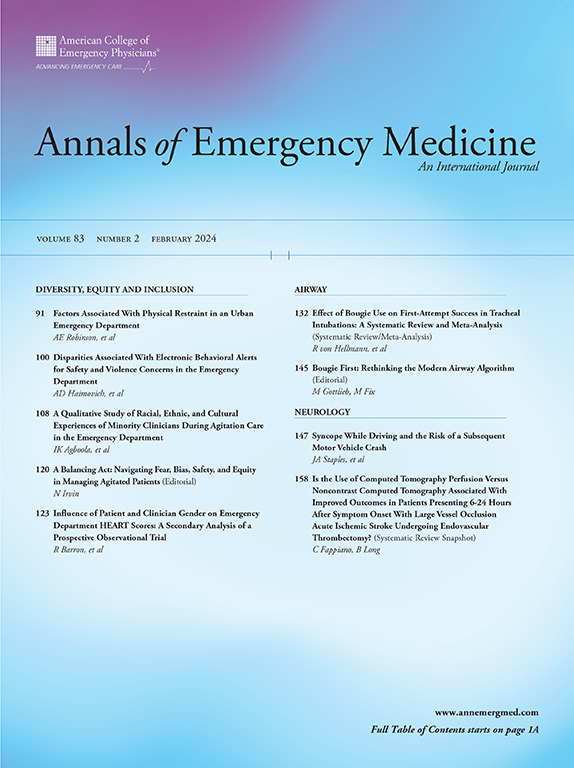Arterial Doppler Ultrasound Blood Flow Waveforms During Chest Compressions to Detect Arterial Line Pulsatility.
IF 5
1区 医学
Q1 EMERGENCY MEDICINE
引用次数: 0
Abstract
STUDY OBJECTIVE Doppler ultrasound blood flow waveforms during active chest compressions are unique and may allow identification of return of spontaneous circulation. We assessed diagnostic accuracy of 4 identified Doppler ultrasound blood flow waveforms-(1) bidirectional blood flow, (2) minimal blood flow, (3) anterograde dominant blood flow, and (4) pulsatility through compressions-during chest compressions to detect arterial line (a-line) pulsatility during a subsequent pulse check. Secondarily, we assessed if pulsatility through compressions was associated with higher systolic blood pressure (SBP) at pulse check than anterograde dominant blood flow. METHODS We conducted a retrospective, diagnostic accuracy study on a prospectively collected convenience sample of adult, emergency department cardiac arrest patients. All patients had a femoral a-line. Prior to a pulse check, Doppler ultrasound clips of the femoral artery were saved and reviewed. During a pulse check, the presence or absence of an arterial line waveform and the highest SBP were recorded. Accuracy, sensitivity, and specificity of the blood flow waveforms were calculated using generalized estimating equation models. RESULTS Forty-four patients with 123 Doppler ultrasound waveforms and subsequent pulse checks were analyzed. Accuracy of the Doppler ultrasound waveforms was 88.9% (95% confidence interval [CI] 81.3 to 93.7), sensitivity of pulsatility through compressions or anterograde dominant blood flow to detect a-line pulsatility was 97.7% (95% CI 87.7 to 99.6), and specificity of bidirectional blood flow or minimal blood flow for the absence of a-line pulsatility was 81.5% (95% CI 69.3 to 89.6). Estimated least-squares mean SBP was higher (50.9 mmHg [95% CI 25.6 to 76.1 mmHg]) for pulsatility through compressions than anterograde dominant blood flow waveforms. CONCLUSION Arterial Doppler ultrasound waveforms during chest compressions had good diagnostic test characteristics for detecting arterial line pulsatility at subsequent pulse check.胸外按压时动脉多普勒超声血流波形检测动脉线搏动。
研究目的主动胸外按压时的多普勒超声血流波形是独特的,可用于识别自发循环的恢复。我们评估了4种已识别的多普勒超声血流波形的诊断准确性——(1)双向血流,(2)最小血流,(3)顺行优势血流,以及(4)通过按压的脉搏——在随后的脉搏检查中,在胸部按压期间检测动脉线(a线)脉搏。其次,我们评估了搏动性是否与脉搏检查时收缩压(SBP)高于顺行优势血流相关。方法对前瞻性收集的急诊科成人心脏骤停患者进行回顾性、诊断准确性研究。所有患者均有股a线。在脉搏检查之前,保存并检查股动脉的多普勒超声夹。在脉搏检查期间,记录动脉线波形的存在或不存在以及最高收缩压。使用广义估计方程模型计算血流波形的准确性、灵敏度和特异性。结果对44例患者的123个多普勒超声波形及脉搏检查进行了分析。多普勒超声波形的准确性为88.9%(95%可信区间[CI] 81.3 ~ 93.7),通过压迫或顺行优势血流检测a线脉搏的敏感性为97.7% (95% CI 87.7 ~ 99.6),双向血流或最小血流量检测a线脉搏的特异性为81.5% (95% CI 69.3 ~ 89.6)。与顺行优势血流波形相比,经压迫的搏动性估计最小二乘平均收缩压(50.9 mmHg [95% CI 25.6至76.1 mmHg])更高。结论胸外按压时动脉多普勒超声波形对后续脉搏检查中检测动脉线脉性具有良好的诊断试验特点。
本文章由计算机程序翻译,如有差异,请以英文原文为准。
求助全文
约1分钟内获得全文
求助全文
来源期刊

Annals of emergency medicine
医学-急救医学
CiteScore
8.30
自引率
4.80%
发文量
819
审稿时长
20 days
期刊介绍:
Annals of Emergency Medicine, the official journal of the American College of Emergency Physicians, is an international, peer-reviewed journal dedicated to improving the quality of care by publishing the highest quality science for emergency medicine and related medical specialties. Annals publishes original research, clinical reports, opinion, and educational information related to the practice, teaching, and research of emergency medicine. In addition to general emergency medicine topics, Annals regularly publishes articles on out-of-hospital emergency medical services, pediatric emergency medicine, injury and disease prevention, health policy and ethics, disaster management, toxicology, and related topics.
 求助内容:
求助内容: 应助结果提醒方式:
应助结果提醒方式:


